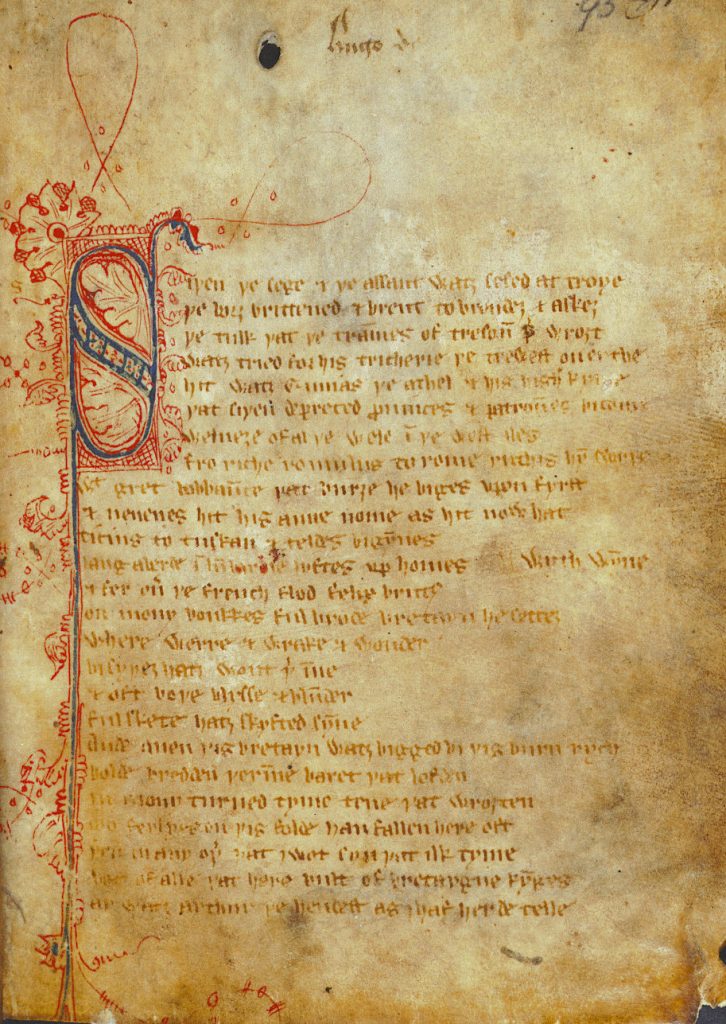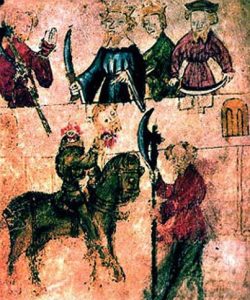The film company A24, behind hit indie films like Lady Bird, Hereditary, and Midsommar has at long last released their adaptation of a classic medieval tale from Camelot. After a year of people avoiding theaters and films pushing back their debuts or resorting to digital releases, The Green Knight has arrived on the big screen.

Source: “Gawayin Poet”, late 14th century, Public domain, via Wikimedia Commons
The source material, Sir Gawain and the Green Knight, is an anonymous 14th century medieval poem. It’s a story of the best of kings, and the most heroic of knights, and how a man already filled with chivalry and grace struggles with a challenge that aims to claim his head. It’s about living legends, and how those who hear of their stories both praise and challenge them.
The original poem explores complex themes and dualities; civilization vs nature, virtue vs temptation, and most crucially, honor vs self preservation. It’s a story full of both Christianity and magic, where a knight can pray for shelter on Christmas Eve and find a castle in the middle of nowhere, and in the same place be offered a magical green girdle that will make him immortal. The fantastic lies around every turn, and the poem explores relationships between normal people and unnatural beings, monsters, and sorceresses.
The Green Knight film takes this fantasy setting and turns it into a dark and bleak world. It’s no less magical, but this rugged terrain is harsh and even Camelot is not impenetrable to the wild forces of nature. The film is shot primarily in blues and greys, a sepia toned filter that leaves everything lackluster and barren during the winter season. A beautiful yet somber soundtack, inspired by medieval chant and instruments, accompanies the haunting shots of Camelot and the wilderness. The scenery and the music combined paint a picture of a harsh yet mystical world that will challenge and press even the most experienced and best of knights.
And in this tale, Gawain is far from a legendary member of the Round Table. When he begins the story, he’s no one. He’s not a knight, he’s not virtuous, and he has no story to tell his uncle, King Arthur, at the Christmas celebration. Gawain instead is an everyman, a young person who everyone is waiting for to grow up and make something of himself. To a college student, he’s far more relatable than the seasoned knight from the original. Here, despite being a nobleman through his relationship with the king, he hasn’t been accepted by Arthur. He’s in love with a prostitute, and wakes up on Christmas morning in a brothel. At the Christmas feast, King Arthur invites him to sit beside his throne for the first time, and Gawain can’t give Arthur a story of his deeds. This man is the opposite of the humble yet chivalrous Gawain we meet at the Christmas celebration, sitting beside King Arthur.
The story takes a more familiar turn as a new visitor enters Camelot’s feast; a towering giant summoned by Morgan Le Fey, formed out of bark, and wearing plate armor. He bears a challenge in the form of a game:
“Oh, Greatest Of Kings, indulge me in this friendly Christmas game. Let whichever of your knights is boldest of blood and wildest of heart step forth, take up arms, and try with honor to land a blow against me. Whomsoever nicks me shall lay claim to this, my arm. It’s glory and riches shall be thine. But thy champ must bind himself to this. Should he land a blow, then one year and Yuletide hence, he must seek me out yonder, to the Green Chapel six nights to the North. He shall find me there, and bend the knee, and let me strike him in return. Be it a scratch on the cheek, or a cut on the throat, I will return what was given to me, and then in trust and friendship we shall part. Who, then, who is willing to engage with me?”

Source: Anonymous artist. The surviving manuscript is a copy., Public domain, via Wikimedia Commons
Gawain sees his chance at doing something worth telling a story about, and accepts the challenge to Camelot’s court. As in the story, Arthur reminds Gawain that it’s “only a game,” and that both he and the Green Knight can walk away if Gawain is wise. The Green Knight has other ideas. Gawain approaches with the King’s own sword, and the challenger kneels and offers his neck. Gawain obliges and cuts off the Green Knight’s head. In a wonderful shot bordering on spooky and comedy, Gawain turns to face Arthur; and we’re treated to the view of the Green Knight’s headless body rising to his feet behind Gawain’s back. The Green Knight’s severed head speaks for the first time, reminding Gawain that he’ll see him in one year, and the Knight rides off cackling into the streets of Camelot. And so the daunting fate of Gawain is set before him, and the rest of the movie sends Gawain journeying towards his own demise.
If you haven’t yet seen the film, watch it before the next part of the review. It’s worth seeing with fresh eyes, and the narrative is full of unexpected twists and turns even for those familiar with the original tale. The performances are spectucular from the small cast, and the plot will have you on the edge of your seat and also wondering at the meanings of chivalry, honor, and the tropes of the hero’s journey. It’s a thrilling yet cerebral ride.
Join us in two weeks for further discussion of the ending of this haunting film, and if you have a chance, go watch it! I know I’ll be watch it again when it releases October 12th.
One Comment
Comments are closed.